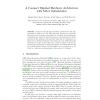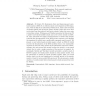ASIACRYPT
2001
Springer
14 years 5 months ago
2001
Springer
This paper describes several speedups and simplifications for XTR. The most important results are new XTR double and single exponentiation methods where the latter requires a chea...
ASIACRYPT
2001
Springer
14 years 5 months ago
2001
Springer
Compact and high-speed hardware architectures and logic optimization methods for the AES algorithm Rijndael are described. Encryption and decryption data paths are combined and all...
ASIACRYPT
2001
Springer
14 years 5 months ago
2001
Springer
In this paper we formalize the notion of a ring signature, which makes it possible to specify a set of possible signers without revealing which member actually produced the signatu...
ASIACRYPT
2001
Springer
14 years 5 months ago
2001
Springer
Let A be a Feistel scheme with 5 rounds from 2n bits to 2n bits. In the present paper we show that for most such schemes A:
ASIACRYPT
2001
Springer
14 years 5 months ago
2001
Springer
Threshold cryptosystems and signature schemes give ways to distribute trust throughout a group and increase the availability of cryptographic systems. A standard approach in design...
ASIACRYPT
2001
Springer
14 years 5 months ago
2001
Springer
We study the two-party commitment problem, where two players have secret values they wish to commit to each other. Traditional commitment schemes cannot be used here because they d...
ASIACRYPT
2001
Springer
14 years 5 months ago
2001
Springer
The Advanced Encryption Standard (AES) provides three levels of security: 128, 192, and 256 bits. Given a desired level of security for the AES, this paper discusses matching publi...
ASIACRYPT
2001
Springer
14 years 5 months ago
2001
Springer
Abstract. At Crypto ’88, Matsumoto, Kato and Imai proposed a protocol, known as RSA-S1, in which a smart card computes an RSA signature, with the help of an untrusted powerful se...
ASIACRYPT
2001
Springer
14 years 5 months ago
2001
Springer
With chosen-IV chosen texts, David Wagner has analyzed the multiple modes of operation proposed by Eli Biham in FSE’98. However, his method is too unrealistic. We use only known-...
ASIACRYPT
2001
Springer
14 years 5 months ago
2001
Springer
Abstract. We give a careful, fixed-size parameter analysis of a standard [1,4] way to form a pseudorandom generator by iterating a one-way function and then pseudo-random function...


